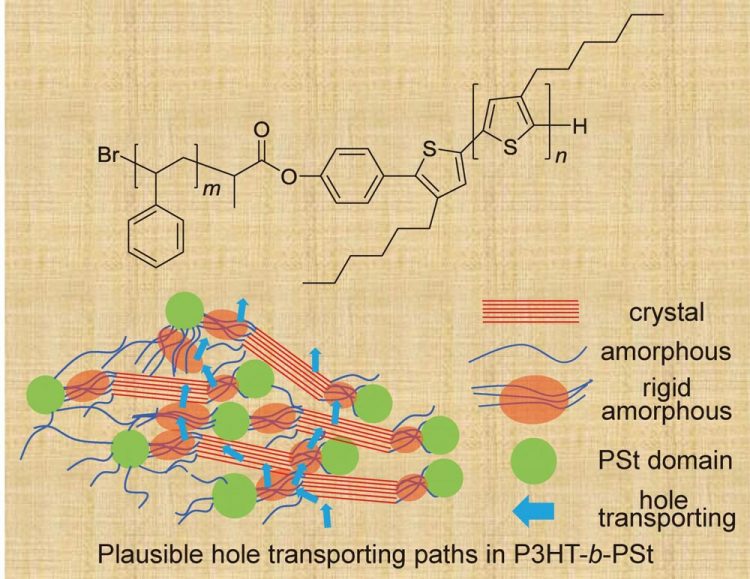Electrical enhancement: Engineers speed up electrons in semiconductors

Chemical structure of poly(P3HT)-b-(PSt) and a diagram of Plausible hole transporting paths in P3HT-b-PSt. Credit: Figure adapted with permission from the front cover of Macromol. Chem. Phys. 18/2018. Copyright © 2018, John Wiley and Sons
Led by Kenji Ogino, a professor at Graduate School of Bio-Applications and Systems Engineering at TUAT, Japan, the team found that adding polystyrene, commonly known as Styrofoam in North America, could enhance the semiconducting polymer by allowing electrons to move from plane to plane quickly.
The process, called hole mobility, is how electrons move through an electric field consisting of multiple layers. When a molecule is missing an electron, an electron from a different plane can jump or fall and take its place.
Through various imaging techniques, it's fairly easy to follow the electron trail in the crystal-based structures. In many semiconducting polymers, however, the clean, defined lines of the crystalline skeleton intertwine with a much more difficult-to-define region. It's actually called the amorphous domain.
“[Electrons] transport in both crystalline and amorphous domains. To improve the total electron mobility, it is necessary to control the nature of the amorphous domain,” Ogino said. “We found that hole mobility extraordinarily improved by the introduction of polystyrene block accompanied by the increase of the ratio of rigid amorphous domain.”
The researchers believe that the way the crystalline domain connects within itself occurs most effectively through the rigid amorphous domain. The addition of polystyrene introduced more amorphous domain, but contained by flexible chains of carbon and hydrogen atoms. Even though the chains are flexible, it provides rigidity, and some degree of control, to the amorphous domain.
Electrons moved two to three times quicker than normal.
“The introduction of a flexible chain in semicrystalline polymers is one of the promising strategies to improve the various functionalities of polymer films by altering the characteristics of the amorphous domain,” Ogino said. “We propose that the rigid amorphous domain plays an important role in the hole transporting process.”
Enhanced hole mobility is a critical factor in developing more efficient solar devices, according to Ogino. Next, Ogino and the researchers plan to examine how the enhanced hole mobility affected other parameters, such as the chemical composition and position of the structures within the polymer film.
###
The rest of the paper authors are Eri Tomita, Kyusun Kim, Kazushi Minegishi, Akitaka Nakamura, and Shinji Kanehashi. They are all affiliated with Graduate School of Bio-Applications and Systems Engineering at TUAT.
This work was partially funded by the Grant-in-Aid for Scientific Research from the Japan Society for the Promotion of Science.
About Tokyo University of Agriculture and Technology
Tokyo University of Agriculture and Technology (TUAT) is a distinguished university in Japan dedicated to science and technology.
TUAT focuses on agriculture and engineering that form the foundation of industry, and promotes education and research fields that incorporate them. Boasting a history of over 140 years since our founding in 1874, TUAT continues to boldly take on new challenges and steadily promote fields. With high ethics, TUAT fulfills social responsibility in the capacity of transmitting science and technology information towards the construction of a sustainable society where both human beings and nature can thrive in a symbiotic relationship.
For more information, please visit http://www.
Original publication:
Enhancement of Out-of-Plane Hole Mobility in Poly(3-Hexylthiophene)-b-Poly(styrene) Film. Eri Tomita, Kyusun Kim, Kazushi Minegishi, Akitaka Nakamura, Shinji Kanehashi, Kenji Ogino.
Macromolecular Chemistry and Physics, 219 (18), 1800186-, 2018
DOI: 10.1002/macp.201800186
Contact:
Kenji Ogino
Graduate School of Bio-Applications and Systems Engineering, Tokyo University of Agriculture and Technology, Japan
kogino@cc.tuat.ac.jp
For more information about the Ogino laboratory, please visit http://web.
Media Contact
More Information:
http://dx.doi.org/10.1002/macp.201800186All latest news from the category: Life Sciences and Chemistry
Articles and reports from the Life Sciences and chemistry area deal with applied and basic research into modern biology, chemistry and human medicine.
Valuable information can be found on a range of life sciences fields including bacteriology, biochemistry, bionics, bioinformatics, biophysics, biotechnology, genetics, geobotany, human biology, marine biology, microbiology, molecular biology, cellular biology, zoology, bioinorganic chemistry, microchemistry and environmental chemistry.
Newest articles

Security vulnerability in browser interface
… allows computer access via graphics card. Researchers at Graz University of Technology were successful with three different side-channel attacks on graphics cards via the WebGPU browser interface. The attacks…

A closer look at mechanochemistry
Ferdi Schüth and his team at the Max Planck Institut für Kohlenforschung in Mülheim/Germany have been studying the phenomena of mechanochemistry for several years. But what actually happens at the…

Severe Vulnerabilities Discovered in Software to Protect Internet Routing
A research team from the National Research Center for Applied Cybersecurity ATHENE led by Prof. Dr. Haya Schulmann has uncovered 18 vulnerabilities in crucial software components of Resource Public Key…





















